Prokuplje
Prokuplje (Serbian Cyrillic: Прокупље, Serbian pronunciation: [prǒkupʎe]) is a city and the administrative center of the Toplica District in southern Serbia. According to 2011 census, the city urban area has a population of 27,333 inhabitants, while the administrative area has 44,419 inhabitants.
Prokuplje | |
|---|---|
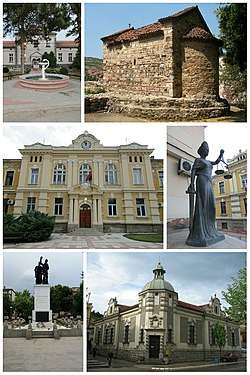 Prokuplje- collage of images: General Hospital, Latin Church, City Hall, Statue on the court building, Monument to World War I heroes, National museum of Toplica. | |
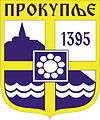 Coat of arms | |
 Location of the city of Prokuplje within Serbia | |
| Coordinates: 43°14′10″N 21°35′25″E | |
| Country | |
| Region | Southern and Eastern Serbia |
| District | Toplica |
| City status | June 2018 |
| Settlements | 107 |
| Government | |
| • Mayor | Aleksandar Simonović (SNS) |
| Area | |
| • Urban | 20.96 km2 (8.09 sq mi) |
| • Administrative | 759 km2 (293 sq mi) |
| Elevation | 273 m (896 ft) |
| Population (2011 census)[2] | |
| • Urban | 27,333 |
| • Urban density | 1,300/km2 (3,400/sq mi) |
| • Administrative | 44,419 |
| • Administrative density | 59/km2 (150/sq mi) |
| Time zone | UTC+1 (CET) |
| • Summer (DST) | UTC+2 (CEST) |
| Postal code | 18400 |
| Area code | +381(0)27 |
| Car plates | PK |
| Website | www |
Prokuplje is one of the Roman sites of Serbia. It was a kaza center in Niš sanjak as "Ürgüp" during Ottoman rule and was incorporated in the Kingdom of Serbia in 1878.
Geography
Prokuplje is located between municipalities of Blace, Kuršumlija, Bojnik, Žitorađa, Merošina, Aleksinac, and Kruševac.
Climate
Prokuplje has an warm-summer mediterranean climate (Köppen climate classification: Cwb) that's close to a humid subtropical climate (Köppen climate classification: Cfa).
| Climate data for Prokuplje | |||||||||||||
|---|---|---|---|---|---|---|---|---|---|---|---|---|---|
| Month | Jan | Feb | Mar | Apr | May | Jun | Jul | Aug | Sep | Oct | Nov | Dec | Year |
| Average high °C (°F) | 4.8 (40.6) |
7.2 (45.0) |
12.6 (54.7) |
18.8 (65.8) |
24.8 (76.6) |
27.2 (81.0) |
30.2 (86.4) |
29.0 (84.2) |
26.2 (79.2) |
19.2 (66.6) |
11.7 (53.1) |
6.0 (42.8) |
18.1 (64.7) |
| Daily mean °C (°F) | 1.8 (35.2) |
3.7 (38.7) |
8.2 (46.8) |
12.7 (54.9) |
18.3 (64.9) |
21.2 (70.2) |
22.6 (72.7) |
21.6 (70.9) |
19.7 (67.5) |
13.3 (55.9) |
9.6 (49.3) |
2.8 (37.0) |
13.0 (55.3) |
| Average low °C (°F) | −2.0 (28.4) |
−0.6 (30.9) |
3.2 (37.8) |
8.6 (47.5) |
12.8 (55.0) |
14.8 (58.6) |
18.2 (64.8) |
17.8 (64.0) |
14.7 (58.5) |
9.6 (49.3) |
5.9 (42.6) |
−0.3 (31.5) |
8.6 (47.4) |
| Average precipitation mm (inches) | 76 (3.0) |
63 (2.5) |
52 (2.0) |
45 (1.8) |
38 (1.5) |
36 (1.4) |
29 (1.1) |
30 (1.2) |
38 (1.5) |
49 (1.9) |
60 (2.4) |
57 (2.2) |
573 (22.5) |
| Source: Climate-Data.org [3] | |||||||||||||
History and archaeology
Neolithic and Copper Age
The traces of early settlements can be found at Neolithic sites such as Macina (near Zitni Potok), Kavolak 6 kilometres (4 miles) west of Prokuplje (village Donja Trnava) and settlements on the south slopes of Jastrebac in Donja Bresnica village. The Vinča period is preserved at the Pločnik site, situated on the left side of the road from Prokuplje to Kursumlija, 19 km [12 mi] west of Prokuplje, underneath the modern village, on the left bank of the Toplica river.[4] Together with Belovode, Pločnik is one of two Vinča culture sites from Serbia considered (as of 2014) the worldwide earliest to produce evidence of copper smelting.[4] The occupation periods are between c. 5350-4650 BC for Belovode and 5200-4650 BC for Pločnik, making Pločnik the second-oldest copper smelting site so far discovered anywhere in the world.[4] There are two theories about the emergence of metalworking: the smelting technology was either discovered in one region only, at or near the Fertile Crescent in what is now southern Iran and emanated from there around the world, or it happened independently in different places, the Vinča culture area of Serbia and Bulgaria being one of them, and for now the oldest to be researched and dated.[5] In October 2008, Serbian archaeologists at Pločnik found a copper axe believed to be 7,500 years old, making it 500–800 years older than what had previously been considered to be the beginning of the Copper Age and suggesting that the human use of metal is older than previously believed.[6][7]
Classical antiquity
The agricultural Vinča settlements were replaced by the emerging Thracians and then the invading Celtic Scordisci in 279 BC. Pieces of ceramics found by the Latin Church are traces of those tribes' movement on their way to Greece.
Between 73-75 BC, after the Romans subjugated the tribes of the region, this part of Serbia became a part of the Roman province of Moesia. At the time the settlement was known as Hammeum or Hameo, its oldest preserved name. It was located on the Roman Via Militaris, a road that connected the central Balkans with the Adriatic, passing through nearby Naissus (Niš). In July 2008 a major Roman spa was unearthed.[8]
At the end of the 4th century AD, when the Roman Empire was divided, the Toplica region became part of the Eastern Roman or Byzantine Empire. The place became known as Komplos or Komblos (village-town). Some historians believe that Komplos was rebuilt by Emperor Justinian (r. 527–565).
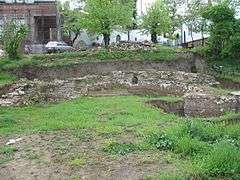 Remains of Roman Baths
Remains of Roman Baths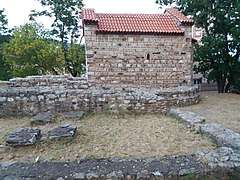 Latin Church
Latin Church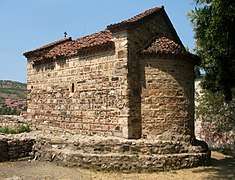 Latin Church
Latin Church
Middle Ages: the Slavs
When South Slavic tribes first settled in this area in the 6th century, Komplos was rendered as the Slavic Prokuplje.
The first written document mentioning today's town name is from AD 1395, when Duchess Milica gave as a present to St. Panteleimon Monastery on holy Mount Athos in modern-day Greece, two houses and some other property from the town of St. Prokopius. Today's name of the town of Prokuplje was first seen in use after the translation of the relics of St. Prokopius from Niš to Prokuplje[9] in 1396.
In the Early Middle Ages, during the rule of Stefan Nemanja, Prokuplje is not mentioned in any written documents. From the 7th century and during the Middle Ages, Slavs who settled there became majority in the area, as could be seen from mainly Slavic toponyms. There was a small population consisting of Romanised Vlachs, who mainly left the area in the past, as the Morava basin was the main invasion route for the attacks on the Roman Empire.[10][11] The settlement gained its importance during the reign of Tsar Lazar Hrebeljanović, before the Ottoman invasion, when the fortress on Hisar Hill was rebuilt.[12] Between 1385 and 1387, the Battle of Pločnik took place in the Toplica region, in which the Serbian forces of Prince Lazar defeated the invading Ottoman army of Sultan Murad I.[12][13]
Ottoman rule
15th-17th centuries
In 1454, Prokuplje was besieged by the Ottomans and during the next 423 years of Ottomans rule the name of the place was Urcub or Okrub. It was part of the Sanjak of Niš.[14]
During the Ottoman rule, in the period between the 16th and 17th centuries, the town's importance increased, similarly to other towns in the region, such as Kruševac, Stalac and Leskovac. Prokuplje prospered through the trade connections with Dubrovnik.[15]
1689-1878: wars and ethnic changes
During the Great Turkish War (1683-1699), there was a massive local rebellion of Christian Serbs in support of the Austrian troops who were advancing in the area. Prokuplje was captured by Austrian troops and Serbian Militia in 1689, but after the Ottoman counter-offensive, the town was burned down during the Austrian retreat of 1690, in spite of Habsburg colonel Antonije Znorić's orders to the contrary.[15] Serbs, who had supported the Austrian troops, after their withdrawal started increasingly emigrating from the area,[16] while there was an increase of Muslim Albanian migration into the town.[11]
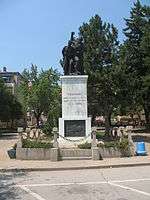
Toponyms such as Arbanaška and Đjake shows an Albanian presence in the Toplica and Southern Morava regions (located north-east of contemporary Kosovo) that dates to the medieval era.[17][18] The rural parts of Toplica valley and adjoining semi-mountainous interior was inhabited during Ottoman rule by compact Muslim Albanian population, while Serbs in those areas lived near the river mouths and mountain slopes; both peoples inhabited other regions of the South Morava river basin.[19][20] As the wider Toplica region,[21] Prokuplje also had an Albanian majority.[22]
During the 1877–1878 period, these Albanians were expelled by Serbian forces[23][24][25] in a way that today would be characterized as ethnic cleansing.[26]
Modern Serbia and Yugoslavia (1877-)
In 1877, the entire Toplica region was captured from the Ottomans by Serbian forces, with Prokuplje changing hands on 19 December 1877. The Berlin Congress of 1878 recongised the city and the wider area as part of Serbia.
From 1929 to 1941, Prokuplje was part of the Morava Banovina of the Kingdom of Yugoslavia. During the First and Second World War Prokuplje was completely destroyed, but in the post-war period it became an industrial town.
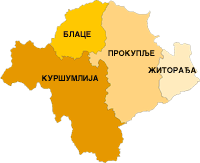
In June 2018, Prokuplje gained the status of a city, along with Bor.[27]
Demographics
| Year | Pop. | ±% p.a. |
|---|---|---|
| 1948 | 59,292 | — |
| 1953 | 62,614 | +1.10% |
| 1961 | 60,075 | −0.52% |
| 1971 | 57,315 | −0.47% |
| 1981 | 56,256 | −0.19% |
| 1991 | 52,969 | −0.60% |
| 2002 | 48,501 | −0.80% |
| 2011 | 44,419 | −0.97% |
| Source: [28] | ||
According to the last official census done in 2011, the city of Prokuplje has 44,419 inhabitants. A total of 61.5% of its population is living in urban areas. Prokuplje has 14,814 households with 3,00 members on average, while the number of homes is 22,898.[29]
Religion structure in Prokuplje is predominantly Serbian Orthodox (41,494), with minorities like Muslims (289), Atheists (122), Catholics (76) and others.[30] Most of the population speaks Serbian language (41,764).[30]
The composition of population by sex and average age:[30]
- Male - 22,056 (40.90 years) and
- Female - 22,363 (43.65 years).
A total of 17,777 citizens (older than 15 years) have secondary education (47.1%), while the 5,002 citizens have higher education (13.3%). Of those with higher education, 2,700 (7.2%) have university education.[31]
Ethnic groups
Most of Prokuplje's population is of Serb ethnicity (92.16%). The ethnic composition of the city:
| Ethnic group | Population | % |
|---|---|---|
| Serbs | 40,936 | 92.16% |
| Roma | 2,145 | 4.83% |
| Montenegrins | 113 | 0.25% |
| Romanians | 75 | 0.17% |
| Macedonians | 74 | 0.17% |
| Croats | 35 | 0.08% |
| Gorani | 24 | 0.05% |
| Others | 1,017 | 2.29% |
| Total | 44,419 |
Economy
Prokuplje has a weak economy, with most of the employed people working in public sector. In 2009, Leoni Wiring Systems Southeast opened a factory in Prokuplje, employing around 1,750 people as of 2013.[32]
The following table gives a preview of total number of registered people employed in legal entities per their core activity (as of 2018):[33]
| Activity | Total |
|---|---|
| Agriculture, forestry and fishing | 107 |
| Mining and quarrying | 1 |
| Manufacturing | 4,575 |
| Electricity, gas, steam and air conditioning supply | 95 |
| Water supply; sewerage, waste management and remediation activities | 353 |
| Construction | 364 |
| Wholesale and retail trade, repair of motor vehicles and motorcycles | 1,441 |
| Transportation and storage | 285 |
| Accommodation and food services | 290 |
| Information and communication | 96 |
| Financial and insurance activities | 96 |
| Real estate activities | 6 |
| Professional, scientific and technical activities | 265 |
| Administrative and support service activities | 101 |
| Public administration and defense; compulsory social security | 986 |
| Education | 795 |
| Healthcare and social work | 1,184 |
| Arts, entertainment and recreation | 238 |
| Other service activities | 144 |
| Individual agricultural workers | 204 |
| Total | 11,627 |
Gallery
 Prokuplje City Hall
Prokuplje City Hall City Hall
City Hall City center Monument
City center Monument National Museum
National Museum City Court
City Court- Church in Kondželj
 City panorama
City panorama City panorama
City panorama Rastovnica Lake
Rastovnica Lake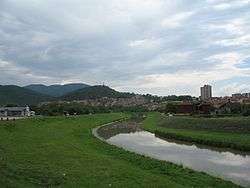 Toplica River
Toplica River
International relations
Twin towns – Sister cities
Prokuplje is twinned with:



See also
References
- "Municipalities of Serbia, 2006". Statistical Office of Serbia. Retrieved 2010-11-28.
- "2011 Census of Population, Households and Dwellings in the Republic of Serbia: Comparative Overview of the Number of Population in 1948, 1953, 1961, 1971, 1981, 1991, 2002 and 2011, Data by settlements" (PDF). Statistical Office of Republic Of Serbia, Belgrade. 2014. ISBN 978-86-6161-109-4. Retrieved 2014-06-27.
- "Climate: Prokuplje, Serbia". Climate-Data.org. Retrieved 14 February 2018.
- Radivojević, Miljana; Kuzmanović-Cvetković, Julka. "Copper minerals and archaeometallurgical materials from the Vinča culture sites of Belovode and Pločnik: Overview of the evidence and new data" (PDF). Starinar. 2014: 7–30. doi:10.2298/STA1464007R. Retrieved 27 June 2020.
- Bower, Bruce (25–26 June 2010). "Serbian site may have hosted first copper makers". Science News. Retrieved 27 June 2020 – via The Archaeology News Network.
- "Ancient axe find suggests Copper Age began earlier than believed". thaindian.com. Retrieved 9 April 2018.
- "Stone Pages Archaeo News: Ancient metal workshop found in Serbia". www.stonepages.com. Retrieved 9 April 2018.
- "Archived copy". Archived from the original on 2011-06-07. Retrieved 2009-07-21.CS1 maint: archived copy as title (link)
- St. Prokopius, on the website of the International Symposium "Niš and Byzantium" 2020 project
- Silviu, Dragomir (2002). Vlahii și Morlacii: studiu din istoria românismului balcanic. Do-minoR. p. 99. ISBN 9789738590168.
- Rudić, Vujadin (1992). Population of Prokuplje. Belgrade: Ethnographic institute, SANU. pp. 11–12. ISBN 978-86-7587-011-1.
- Namık, Kemal (1982). Osmanlı tarihi: Anadolu Selçukluları ve Anadolu beylikleri hakkında bir mukaddime ile Osmanlı devleti'nin kuruluşundan İstanbul'un fethine kadarv̲̲. 2. İstanbul'un fethinden Kanunı̂ Sultan Süleyman'nın ölümüne kadar (4 ed.). Türk Tarih Kurumu. pp. 200, 219, 250.
- Colin, Imber (1990). The Ottoman empire: 1300-1481. Isis. p. 35. ISBN 9789754280159. Retrieved 12 January 2019.
- Godišnjak grada Beograda. Museum of the Belgrade. 1977. p. 116. Retrieved 11 July 2011.
- Kostić, Radoje. "Нишка Епархија у првој половини 18. века". Niš: Istorijski Arhiv Niš. Archived from the original on 4 September 2011. Retrieved 14 December 2011.
Прокупље је запалио пуковник Антоније Знорић приликом повлачења 1690. године
- Shaw, Stanford J.; Shaw, Ezel Kural (1976). History of the Ottoman Empire and Modern Turkey: Volume 1, Empire of the Gazis: The Rise and Decline of the Ottoman Empire 1280-1808. Cambridge University Press. pp. 219–221. ISBN 9780521291637. Retrieved 12 January 2019.
- Uka, Sabit (2004). Jeta dhe veprimtaria e shqiptarëve të Sanxhakut të Nishit deri më 1912 [Life and activity of Albanians in the Sanjak of Nish up to 1912]. Verana. pp. 244–245. ISBN 9789951864527.
Eshtë, po ashtu, me peshë historike një shënim i M. Gj Miliçeviqit, i cili bën fjalë përkitazi me Ivan Begun. Ivan Begu, sipas tij ishte pjesëmarrës në Luftën e Kosovës 1389. Në mbështetje të vendbanimit të tij, Ivan Kullës, fshati emërtohet Ivan Kulla (Kulla e Ivanit), që gjendet në mes të Kurshumlisë dhe Prokuplës. M. Gj. Miliçeviqi thotë: "Shqiptarët e ruajten fshatin Ivan Kullë (1877–1878) dhe nuk lejuan që të shkatërrohet ajo". Ata, shqiptaret e Ivan Kullës (1877–1878) i thanë M. Gj. Miliçeviqit se janë aty që nga para Luftës se Kosovës (1389). [12] Dhe treguan që trupat e arrave, që ndodhen aty, ata i pat mbjellë Ivan beu. Atypari, në malin Gjakë, nodhet kështjella që i shërbeu Ivanit (Gjonit) dhe shqiptarëve për t’u mbrojtur. Aty ka pasur gjurma jo vetëm nga shekulli XIII dhe XIV, por edhe të shekullit XV ku vërehen gjurmat mjaft të shumta toponimike si fshati Arbanashka, lumi Arbanashka, mali Arbanashka, fshati Gjakë, mali Gjakë e tjerë. [13] Në shekullin XVI përmendet lagja shqiptare Pllanë jo larg Prokuplës. [14] Ne këtë shekull përmenden edhe shqiptarët katolike në qytetin Prokuplë, në Nish, në Prishtinë dhe në Bulgari.[15].... [12] M. Đj. Miličević. Kralevina Srbije, Novi Krajevi. Beograd, 1884: 354. "Kur flet mbi fshatin Ivankullë cekë se banorët shqiptarë ndodheshin aty prej Betejës së Kosovës 1389. Banorët e Ivankullës në krye me Ivan Begun jetojnë aty prej shek. XIV dhe janë me origjinë shqiptare. Shqiptarët u takojnë të tri konfesioneve, por shumica e tyre i takojnë atij musliman, mandej ortodoks dhe një pakicë i përket konfesionit katolik." [13] Oblast Brankovića, Opširni katastarski popis iz 1455 godine, përgatitur nga M. Handžic, H. Hadžibegić i E. Kovačević, Sarajevo, 1972: 216. [14] Skënder Rizaj, T,K "Perparimi" i vitit XIX, Prishtinë 1973: 57.[15] Jovan M. Tomić, O Arnautima u Srbiji, Beograd, 1913: 13. [It is, as such, of historic weight in a footnote of M. Đj. Miličević, who says a few words regarding Ivan Beg. Ivan Beg, according to him participated in the Battle of Kosovo in 1389. In support of his residence, Ivan Kula, the village was named Ivan Kula (Tower of Ivan), located in the middle of Kuršumlija and Prokuple. M. Đj. Miličević says: "Albanians safeguarded the village Ivan Kula (1877–1878) and did not permit its destruction." Those Albanians of Ivan Kulla (1877–1878) told M.Đj. Miličević that they have been there since before the Kosovo War (1389). And they showed where the bodies of the walnut trees were, that Ivan Bey had planted. Then there to Mount Đjake, is the castle that served Ivan (John) and Albanians used to defend themselves. There were traces not only from the XIII and XIV centuries, but the XV century where we see fairly multiple toponymic traces like the village Arbanaška, river Arbanaška, mountain Arbanaška, village Đjake, mountain Đjake and others. In the sixteenth century mentioned is the Albanian neighborhood Plana not far from Prokuple. [14] In this century is mentioned also Catholic Albanians in the town of Prokuplje, Niš, Priština and in Bulgaria.[15].... [12] M. Đj. Miličević. Kralevina Srbije, Novi Krajevi. Beograd, 1884: 354. When speaking about the village Ivankula, its residents state that Albanians were there from the Battle of Kosovo in 1389. Residents of Ivankula headed by Ivan Beg are living there since the XIV century and they are of Albanian origin. Albanians belong to three religions, but most of them belong to the Muslim one, after Orthodoxy and then a minority belongs to the Catholic confession. [13] Oblast Brankovića, Opširni katastarski popis iz 1455 godine, përgatitur nga M. Handžic, H. Hadžibegić i E. Kovačević, Sarajevo, 1972: 216. [14] Skënder Rizaj, T,K "Perparimi" i vitit XIX, Prishtinë 1973: 57. [15] Jovan M. Tomić, O Arnautima u Srbiji, Beograd, 1913: 13.]
- Geniş, Şerife; Maynard, Kelly Lynne (2009). "Formation of a Diasporic Community: The History of Migration and Resettlement of Muslim Albanians in the Black Sea Region of Turkey". Middle Eastern Studies. 45 (4): 556–557. doi:10.1080/00263200903009619.
Using secondary sources, we establish that there have been Albanians living in the area of Nish for at least 500 years, that the Ottoman Empire controlled the area from the fourteenth to nineteenth centuries which led to many Albanians converting to Islam, that the Muslim Albanians of Nish were forced to leave in 1878, and that at that time most of these Nishan Albanians migrated south into Kosovo, although some went to Skopje in Macedonia. ; p. 557. It is generally believed that the Albanians in Samsun Province are the descendants of the migrants and refugees from Kosovo who arrived in Turkey during the wars of 1912–13. Based on our research in Samsun Province, we argue that this information is partial and misleading. The interviews we conducted with the Albanian families and community leaders in the region and the review of Ottoman history show that part of the Albanian community in Samsun was founded through three stages of successive migrations. The first migration involved the forced removal of Muslim Albanians from the Sancak of Nish in 1878; the second migration occurred when these migrants’ children fled from the massacres in Kosovo in 1912–13 to Anatolia; and the third migration took place between 1913 and 1924 from the scattered villages in Central Anatolia where they were originally placed to the Samsun area in the Black Sea Region. Thus, the Albanian community founded in the 1920s in Samsun was in many ways a reassembling of the demolished Muslim Albanian community of Nish…. Our interviews indicate that Samsun Albanians descend from Albanians who had been living in the villages around the city of Nish… pp. 557–558. In 1690 much of the population of the city and surrounding area was killed or fled, and there was an emigration of Albanians from the Malësia e Madhe (North Central Albania/Eastern Montenegro) and Dukagjin Plateau (Western Kosovo) into Nish.
- Jagodić 1998, para. 4, 9, 32–42, 45–61.
- Luković, Miloš (2011). "Development of the Modern Serbian state and abolishment of Ottoman Agrarian relations in the 19th century". Český lid. Institute of Ethnology, Czech Academy of Sciences. 98 (3): 298.
During the second war (December 1877 — January 1878) the Muslim population fled towns (Vranya (Vranje), Leskovac, Ürgüp (Prokuplje), Niş (Niš), Şehirköy (Pirot), etc.) as well as rural settlements where they comprised ethnically compact communities (certain parts of Toplica, Jablanica, Pusta Reka, Masurica and other regions in the South Morava River basin). At the end of the war these Muslim refugees ended up in the region of Kosovo and Metohija, in the territory of the Ottoman Empire, following the demarcation of the new border with the Principality of Serbia. [38] [38] On Muslim refugees (muhaciri) from the regions of southeast Serbia, who relocated in Macedonia and Kosovo, see Trifunovski 1978, Radovanovič 2000.
- Bataković, Dušan T. (2007). "(title behind paywall/June 2020)". Kosovo and Metohija: living in the enclave. Special editions, volume 96. Serbian Academy of Sciences and Arts, Institute for Balkan Studies: 35. ISSN 0352-1869. Retrieved 22 June 2011.
Prior to the Second Serbo-Ottoman War (1877-78), Albanians were the majority population in some areas of Sanjak of Nis (Toplica region), while from the Serb majority district of Vranje Albanian-inhabited villages were emptied after the 1877-1878 war
- Sinisa Ljepojevic (30 October 2008). Kosovo Murky Reality. AuthorHouse. p. 168. ISBN 978-1-4670-2278-1.
Prokuplje, town in Serbia, was then, for example, a place with Albanian majority.
- Turović, Dobrosav (2002). Gornja Jablanica, Kroz istoriju. Beograd Zavičajno udruženje. pp. 87–89.
- Uka, Sabit (2004). Gjurmë mbi shqiptarët e Sanxhakut të Nishit deri më 1912 [Traces on Albanians of the Sanjak of Nish up to 1912]. Verana. p. 155. ISBN 9789951864527.
Në kohët e sotme fshatra të Jabllanicës, të banuara kryesisht me shqiptare, janë këto: Tupalla, Kapiti, Gërbavci, Sfirca, Llapashtica e Epërrne. Ndërkaq, fshatra me popullsi te përzier me shqiptar, malazezë dhe serbë, jane këto: Stara Banja, Ramabanja, Banja e Sjarinës, Gjylekreshta (Gjylekari), Sijarina dhe qendra komunale Medvegja. Dy familje shqiptare ndeshen edhe në Iagjen e Marovicës, e quajtur Sinanovë, si dhe disa familje në vetë qendrën e Leskovcit. Vllasa është zyrtarisht lagje e fshatit Gërbavc, Dediqi, është lagje e Medvegjes dhe Dukati, lagje e Sijarinës. Në popull konsiderohen edhe si vendbanime të veçanta. Kështu qendron gjendja demografike e trevës në fjalë, përndryshe para Luftës se Dytë Botërore Sijarina dhe Gjylekari ishin fshatra me populisi të perzier, bile në këtë te fundit ishin shumë familje serbe, kurse tani shumicën e përbëjnë shqiptarët. [In contemporary times, villages in the Jablanica area, inhabited mainly by Albanians, are these: Tupale, Kapiti, Grbavce, Svirca, Gornje Lapaštica. Meanwhile, the mixed villages populated by Albanians, Montenegrins and Serbs, are these: Stara Banja, Ravna Banja, Sjarinska Banja, Đulekrešta (Đulekari) Sijarina and the municipal center Medveđa. Two Albanian families are also encountered in the neighborhood of Marovica called Sinanovo, and some families in the center of Leskovac. Vllasa is formally a neighborhood of the village Grbavce, Dedići is a neighborhood of Medveđa and Dukati, a neighborhood of Sijarina. So this is the demographic situation in question that remains, somewhat different before World War II as Sijarina and Đulekari were villages with mixed populations, even in this latter settlement were many Serb families, and now the majority is made up of Albanians.]
- Blumi, Isa (2013). Ottoman refugees, 1878–1939: migration in a post-imperial world. A&C Black. p. 50. ISBN 9781472515384.
As these Niš refugees waited for acknowledgment from locals, they took measures to ensure that they were properly accommodated by often confiscating food stored in towns. They also simply appropriated lands and began to build shelter on them. A number of cases also point to banditry in the form of livestock raiding and "illegal" hunting in communal forests, all parts of refugees’ repertoire... At this early stage of the crisis, such actions overwhelmed the Ottoman state, with the institution least capable of addressing these issues being the newly created Muhacirin Müdüriyeti... Ignored in the scholarship, these acts of survival by desperate refugees constituted a serious threat to the established Kosovar communities. The leaders of these communities thus spent considerable efforts lobbying the Sultan to do something about the refugees. While these Niš muhacir would in some ways integrate into the larger regional context, as evidenced later, they, and a number of other Albanian-speaking refugees streaming in for the next 20 years from Montenegro and Serbia, constituted a strong opposition block to the Sultan’s rule."; p.53. "One can observe that in strategically important areas, the new Serbian state purposefully left the old Ottoman laws intact. More important, when the state wished to enforce its authority, officials felt it necessary to seek the assistance of those with some experience, using the old Ottoman administrative codes to assist judges make rulings. There still remained, however, the problem of the region being largely depopulated as a consequence of the wars... Belgrade needed these people, mostly the landowners of the productive farmlands surrounding these towns, back. In subsequent attempts to lure these economically vital people back, while paying lip-service to the nationalist calls for "purification," Belgrade officials adopted a compromise position that satisfied both economic rationalists who argued that Serbia needed these people and those who wanted to separate "Albanians" from "Serbs." Instead of returning back to their "mixed" villages and towns of the previous Ottoman era, these "Albanians," "Pomoks," and "Turks" were encouraged to move into concentrated clusters of villages in Masurica, and Gornja Jablanica that the Serbian state set up for them. For this "repatriation" to work, however, authorities needed the cooperation of local leaders to help persuade members of their community who were refugees in Ottoman territories to "return." In this regard, the collaboration between Shahid Pasha and the Serbian regime stands out. An Albanian who commanded the Sofia barracks during the war, Shahid Pasha negotiated directly with the future king of Serbia, Prince Milan Obrenović, to secure the safety of those returnees who would settle in the many villages of Gornja Jablanica. To help facilitate such collaborative ventures, laws were needed that would guarantee the safety of these communities likely to be targeted by the rising nationalist elements infiltrating the Serbian army at the time. Indeed, throughout the 1880s, efforts were made to regulate the interaction between exiled Muslim landowners and those local and newly immigrant farmers working their lands. Furthermore, laws passed in early 1880 began a process of managing the resettlement of the region that accommodated those refugees who came from Austrian-controlled Herzegovina and from Bulgaria. Cooperation, in other words, was the preferred form of exchange within the borderland, not violent confrontation.
- Müller, Dietmar (2009). "Orientalism and Nation: Jews and Muslims as Alterity in Southeastern Europe in the Age of Nation-States, 1878–1941". East Central Europe. 36: 63–99. doi:10.1163/187633009x411485.
- "Srbija dobila još dva grada". b92.net (in Serbian). Tanjug. 20 June 2018. Retrieved 20 June 2018.
- "2011 Census of Population, Households and Dwellings in the Republic of Serbia" (PDF). stat.gov.rs. Statistical Office of the Republic of Serbia. Retrieved 12 January 2017.
- "Number and the floor space of housing units" (PDF). stat.gov.rs (in Serbian). Statistical Office of the Republic of Serbia. Retrieved 21 March 2018.
- "Religion, Mother tongue, and Ethnicity" (PDF). stat.gov.rs (in Serbian). Statistical Office of the Republic of Serbia. Retrieved 21 March 2018.
- "Educational attainment, literacy and computer literacy" (PDF). stat.gov.rs (in Serbian). Statistical Office of the Republic of Serbia. Retrieved 21 March 2018.
- "Počela izgradnja druge fabrike kompanije Leoni u Srbiji". blic.rs (in Serbian). 23 August 2013. Retrieved 15 February 2018.
- "MUNICIPALITIES AND REGIONS OF THE REPUBLIC OF SERBIA, 2019" (PDF). stat.gov.rs. Statistical Office of the Republic of Serbia. 25 December 2019. Retrieved 25 December 2019.
- "Association Suisse des Communes et Régions d'Europe". L'Association suisse pour le Conseil des Communes et Régions d'Europe (ASCCRE) (in French). Archived from the original on 2012-07-24. Retrieved 2013-07-20.
